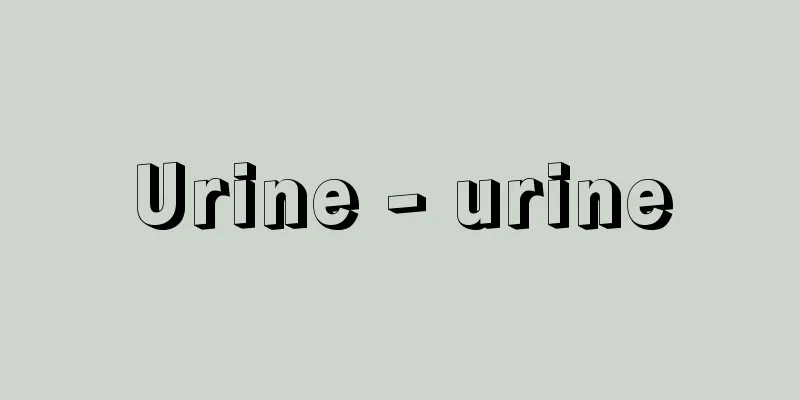Urine - urine

|
It is an excretory substance produced by filtering blood in the kidneys, and forms a solution with the water excreted at the same time. It is also called urine or urine. Blood contains waste products and harmful chemicals produced as a result of metabolic activity in bodily tissues, but these are filtered out to become urine. Therefore, when comparing the components contained in urine with those of plasma, almost none of the components present in plasma that are useful to the body are excreted in urine, while unnecessary components are excreted in high concentrations. The liquid first filtered from plasma in the renal corpuscle of the kidney (consisting of the glomerulus, a collection of capillaries, and the funnel-shaped Bowman's capsule) is called primary urine (glomerular filtrate). The composition of primary urine is equivalent to that of plasma minus the protein components, and it contains not only unnecessary waste products but also large amounts of useful components such as water, sodium, and sugar. However, as this primary urine flows down the renal tubules and collecting ducts that lead to Bowman's capsule, useful components are reabsorbed, while unnecessary components are further secreted, gradually concentrating the urine, which ultimately becomes urine. Urine is transported from the renal pelvis (renal pelvis) to the bladder by the peristalsis of the ureters, where it is stored. When a certain amount of urine accumulates in the bladder, the bladder wall stretches, creating the urge to urinate, and the internal and external vesical sphincters relax, allowing the urine to be excreted from the body. This is called urination. [Hidenobu Mashima] Daily excretion amountA healthy adult excretes about 1500 milliliters of urine per day, and this fluctuation in urine volume is mainly determined by the amount of water consumed. Drinking a lot of water increases the amount of urine, while drinking a little water, sweating a lot, or losing a lot of water from the digestive tract due to diarrhea decreases the amount of urine. In other words, the kidneys regulate the amount of urine according to the amount of water consumed or lost, and balance the amount of water in the body. The minimum limit of urine volume is 500 milliliters per day, and if more urine is not produced than this, waste products cannot be excreted as a solution. When the amount of urine falls below 500 milliliters, it is called oliguria, and when urine is completely lost, it is called anuria or urinary retention, and emergency treatment is required. Conversely, when the amount of urine is continuously more than 3000 milliliters, it is called polyuria, and is observed in cases such as diabetes insipidus. However, even healthy people can have a urine volume of more than 3000 milliliters after consuming a large amount of water. The amount of urine produced is small during sleep at night, but increases during the day, becoming two to four times that of nighttime. The specific gravity of urine is normally 1.012 to 1.025, but this increases or decreases almost inversely proportional to the amount of urine. In other words, when the amount of urine is large, a large amount of water is excreted, so the urine becomes dilute and its specific gravity decreases, but when the amount of urine is small, the amount of water excreted is also small, so the urine is concentrated and its specific gravity increases. [Hidenobu Mashima] Components of urineThe main component of urine is water, which usually accounts for 95% of urine. Therefore, the solid matter in 100 milliliters of urine is an average of 5 grams, of which the most abundant is urea (about 2 grams). Urea is derived from protein, and is excreted by breaking down the proteins ingested in the diet and the proteins that make up the body. In other words, the amount of urea excreted depends greatly on the amount of protein consumed. Also, urine contains an average of 0.6 grams of sodium chloride (salt), which is affected by the amount of salt consumed. Other major substances contained in urine include 0.2 grams of sulfate ions, 0.12 grams of phosphate ions, 0.15 grams of potassium, 0.1 grams of creatinine, as well as uric acid, ammonia, calcium, etc. In addition, sex hormones, vitamins, and ketone bodies are also excreted in small amounts. However, in normal urine, sugar and protein are not detected at all, or only in very small amounts. When sugar is excreted in urine, it is called diabetes mellitus, and is often seen in diabetes. When protein is excreted, it is called proteinuria, which occurs as a result of glomeruli and tubules being damaged by acute or chronic nephritis. The hydrogen ion concentration (pH) of urine is usually in the range of 5.0 to 7.0 (average 6.0), but even in healthy people, this value can vary depending on diet and physical condition. Fresh urine is slightly acidic, but if left unattended, urea breaks down to produce ammonia, turning it alkaline. [Hidenobu Mashima] Urine colorA healthy person's urine is clear and colorless or pale yellow. This color is based on a pigment called urochrome, but its origin is not well understood. The color of urine is dark when the amount of urine is small, and approaches colorless as the amount of urine increases. When urine loses its transparency and becomes cloudy, it is called cloudy urine, and there are the following types: pus mixed in the urine due to inflammation of the urinary tract (urethra, bladder, renal pelvis, etc.), salts are excreted in the urine without dissolving (salturia), and lymph is mixed in the urine due to some cause of communication between the urinary tract and lymphatic vessels (chyleuria). Blood mixed in the urine is called hematuria. If the bleeding is fresh, the urine will be bright red, but if some time has passed since the bleeding, it will be brownish. Hematuria is often caused by inflammation of the kidneys or urinary tract, tumors, or stones, but even healthy people may have hematuria after extremely strenuous exercise. In cases of bile duct obstruction or hepatitis, bilirubin is excreted directly into the urine, causing the urine to turn yellow. This yellowing of the urine is a precursor to jaundice, which precedes the yellowing of the skin. [Hidenobu Mashima] Abnormal urineIt is often the first symptom that makes you aware of the disease. The most important symptoms are proteinuria and glycosuria, both of which are discovered by a urine test. Generally, it is easy to notice the cloudiness, color, and abnormal odor. Important cloudy urine is hematuria, which is mixed with blood, and pyuria, which is yellowish-white due to pus. Other types include chyluria, which is milky, fibrinuria, which is solidified like pudding (both of which are caused by filariasis), seminal urine, which is cloudy due to the presence of semen or prostatic fluid, fecal urine, and pneumuria, which is caused by intestinal gas coming out of the urine and making an unusual sound when urinating (both of which are caused by vesicoenteric fistula). Fresh healthy urine is clear, but if left untreated, it becomes cloudy. When urine becomes alkaline due to food or other factors, carbonates and phosphates precipitate, and the urine becomes cloudy at the time of urination. Also, when urinating into a cold urinal, uric acid salts precipitate and the urine becomes cloudy and brick-colored. Such saluria is temporary and is nothing to worry about. The urine is generally clear, but may contain floating threads (urinary threads) (chronic urethritis). Hematuria is an important color abnormality, but it is not always bright red. In cases of renal hemorrhage, it may be slightly blackish. In addition to hemoglobinuria (caused by poisoning or cold) and melaninuria, which have an appearance reminiscent of hematuria, there are also cases caused by drug or food pigments. In jaundice, the urine turns greenish brown due to bile pigments, and yellowish brown foam appears when the urinal is shaken. There are relatively few abnormal odors, but chronic cystitis and prostatic hyperplasia, especially those with residual urine, can cause a strong foul odor. In diabetes, the presence of acetone can cause the urine to ferment and emit a fruity odor, and in the past, urinary collection workers were sometimes told that there was a patient in their family. Early pregnancy diagnosis by animal testing of pregnant urine has also been used for a long time. [Eiichi Kato] Animal urineIn animals, urine is a liquid that is filtered from body fluids by excretory organs, collected, and excreted from the body. Urine in vertebrates is produced in the kidneys. Freshwater bony fish excrete large amounts of urine that is hypotonic compared to blood. Marine fish excrete small amounts of urine that is isotonic to blood, and actively excrete salts from special cells (chloride cells) in their gills to keep the osmotic pressure of their body fluids lower than that of seawater. In the kidneys of terrestrial vertebrates, urine is produced in the Malpighian corpuscles and renal tubules. In the Malpighian corpuscles, the components of blood in the glomerulus, excluding blood cells and most proteins, are filtered into Bowman's capsule to become primary urine. As the primary urine flows through the renal tubules, useful components such as water, salts, and glucose are reabsorbed into the capillaries. In contrast, waste products such as urea and uric acid are hardly reabsorbed, so the urine is extremely concentrated, consisting only of waste products from the blood components. [Seiichiro Kawashima] [Reference items] | | | | | | | | | | |Source: Shogakukan Encyclopedia Nipponica About Encyclopedia Nipponica Information | Legend |
|
腎臓(じんぞう)において血液が濾過(ろか)されてつくられる排泄(はいせつ)物質で、同時に排泄される水分とともに溶液状態をなし、小便または小水(しょうすい)ともよばれる。血液中には、身体組織の代謝活動の結果生じた老廃物や有害な化学物質が含まれているが、これらが濾過されて尿となる。したがって、尿中に含まれる成分と血漿(けっしょう)成分とを比較してみると、尿中には、血漿中に存在する身体にとって有用な成分はほとんど排泄されず、逆に不要な成分が高濃度に濃縮されて排泄されている。腎臓の腎小体(毛細血管が集合した糸球体と漏斗(ろうと)状のボーマン嚢(のう)からなる)において最初に血漿から濾過された液体を原尿(糸球体濾液)とよぶ。原尿の組成は血漿からタンパク成分を除いたものに等しく、そのなかには不要な老廃物のみならず、水、ナトリウム、糖などの有用な成分も多量に含まれている。しかし、この原尿がボーマン嚢に続く尿細管・集合管を流れ下る間に有用な成分は再吸収され、逆に不要な成分がさらに分泌されてしだいに濃縮され、最終的な尿となる。尿は腎盂(じんう)(腎盤)から尿管の蠕動(ぜんどう)によって膀胱(ぼうこう)に送られ、貯留する。膀胱内にある程度尿がたまると、膀胱壁が伸展されて尿意を生じ、内膀胱括約筋、外膀胱括約筋が弛緩(しかん)して尿は体外に排泄される。これを排尿という。 [真島英信] 1日の排泄量健康成人の場合、尿は1日におよそ1500ミリリットル前後排泄されるが、この尿量の変動は主として水の摂取量によって決まる。水を多量に飲めば尿量は増加し、逆に水の摂取量が少なかったり、発汗が多い場合、あるいは下痢によって消化管からの水の喪失が多い場合には尿量は減少する。すなわち、腎臓は水の摂取量あるいは喪失量に応じて尿量を調節し、体内に含まれる水分量のバランスをとっているのである。尿量の最低限界は1日に500ミリリットルであり、これ以上の尿を出さないと老廃物を水溶液として排出しきることができなくなる。尿量が500ミリリットル以下となった場合を乏尿といい、まったく出なくなるものには無尿と尿閉とがあり、緊急に治療することが必要となる。逆に尿量が持続的に3000ミリリットル以上になった場合を多尿といい、尿崩症のときなどに観察される。ただし、健康人でも水を多量に摂取したあとには、尿量が3000ミリリットルを超える場合もある。尿の生成量は夜間の睡眠中は少ないが、日中は増加して夜間の2~4倍となる。尿の比重は通常1.012~1.025であるが、これは尿量とほぼ反比例して増減する。すなわち、尿量の多いときには水が多量に排泄されているため、尿は希薄となって比重は低下するが、尿量が少ないときは水の排泄量も少ないため、尿は濃縮されて比重は大となる。 [真島英信] 尿の成分尿の主成分は水であり、通常は尿の95%を占める。したがって、尿100ミリリットル中の固形物は平均5グラムであり、そのうち、もっとも多いのは尿素(約2グラム)である。尿素はタンパク質に由来し、食事として摂取したタンパク質、および身体を構成しているタンパク質が分解されて排泄される。つまり、尿素の排泄量はタンパク質の摂取量に大きく左右されるわけである。また、尿中には塩化ナトリウム(食塩)が平均0.6グラム含まれるが、これは食塩の摂取量に影響される。そのほか尿中に含まれる物質のおもなものとしては、硫酸イオン0.2グラム、リン酸イオン0.12グラム、カリウム0.15グラム、クレアチニン0.1グラムのほか、尿酸、アンモニア、カルシウムなどがあげられる。また、微量ではあるが、性ホルモンやビタミン類、ケトン体なども排泄される。しかし、正常な尿においては、糖やタンパク質はまったく、あるいは極微量しか検出されない。尿中に糖が排泄される場合を糖尿といい、糖尿病のときによくみられる。また、タンパク質が排泄される場合をタンパク尿といい、急性腎炎や慢性腎炎にかかって糸球体・尿細管が障害される結果出現するものである。尿の水素イオン濃度(pH)は通常は5.0~7.0の範囲(平均6.0)であるが、健康者でも食事の内容や身体の状態などによってこの値は変化する。なお、新鮮な尿は弱酸性であるが、放置すると尿素が分解されてアンモニアを生じ、アルカリ性に変化する。 [真島英信] 尿の色健康な人の尿は透明であり、色は無色ないし淡黄色である。この色の基になっているのはウロクロムurochromeとよばれる色素であるが、その起源はよくわかっていない。尿の色は、尿量が少ないときは濃く、尿量が多くなるにつれて無色に近づく。尿の透明さが失われて混濁したものを混濁尿といい、次のようなものがある。すなわち、尿路(尿道・膀胱・腎盂など)の炎症によって、そこから膿(のう)が尿中に混じる場合(膿尿)、塩類が不溶解のまま尿中に排泄される場合(塩類尿)、尿路とリンパ管との間になんらかの原因で交通が生じ、尿中にリンパが混じる場合(乳糜(にゅうび)尿)などである。また、尿中に血液が混じる場合を血尿という。新鮮な出血であれば尿は鮮紅色、出血後時間が経過している場合は褐色調となる。血尿は腎臓や尿路の炎症、腫瘍(しゅよう)、あるいは結石などによって出現することが多いが、健康な人でも、きわめて激しい運動のあとには血尿が認められることがある。胆管の閉塞(へいそく)や肝炎などでは尿中に直接ビリルビンが排泄されて尿は黄色に着色する。この尿の黄変は皮膚の黄変に先行する黄疸(おうだん)の先駆症状である。 [真島英信] 異常尿病気に気づく最初の症状となることが多い。重要なものにタンパク尿と糖尿があり、いずれも検尿して発見される。一般に気づきやすいのは、混濁、色調、臭気の異常である。混濁尿で重要なのは、血液の混じった血尿、膿のために黄白色を呈する膿尿である。このほか、牛乳状を呈する乳糜尿や、プディングのように固まる線維素尿(いずれもフィラリアの寄生が原因)をはじめ、精液もしくは前立腺(せん)液が混じって白濁する精液尿、糞便(ふんべん)が混じる糞尿や、腸内ガスが尿とともに出て排尿時に異様な音を発する気尿(ともに膀胱腸瘻(ろう)による)などがある。新鮮な健康尿は透明であるが、放置すると濁ってくる。食物などの関係で尿がアルカリ性になると、炭酸塩やリン酸塩が析出して放尿時にすでに混濁を認める。また、冷たい尿器に排尿すると、尿酸塩が析出してれんが色に濁る。こうした塩類尿は一過性であり、心配はない。 尿は全体として清透であるが、その中に糸屑(いとくず)のようなもの(尿糸)が浮遊することがある(慢性尿道炎)。色調の異常としては血尿が重要であるが、その色はつねに鮮紅色を呈するとは限らない。腎出血などではやや黒みを帯びていることもある。血尿を思わせる外観を呈する血色素尿(中毒や寒冷による)やメラニン尿のほか、薬剤や食物の色素によるものもある。また、黄疸のときには胆汁色素のため緑褐色になり、尿器ごと振ると黄褐色の泡を生ずる。臭気の異常は比較的少ないが、慢性膀胱炎、とくに残留尿のある前立腺肥大症では悪臭がひどくなることがある。また、糖尿病ではアセトンの存在によって尿が発酵して果実臭を発することがあり、かつてはくみ取り従事者に家族内に患者のいることを指摘されることもあった。なお、妊娠尿の動物試験による早期妊娠診断法も古くから行われてきた。 [加藤暎一] 動物の尿動物においても、排出器官により体液から濾過され、集められて体外に排出される溶液状態をなすものを尿という。脊椎(せきつい)動物の尿は腎臓でつくられる。淡水産の硬骨魚類は血液よりも低張の尿を多量に排出する。海産魚は血液と等張の尿を少量排出するとともに、えらにある特別な細胞(塩類細胞)から塩類を積極的に排出して体液の浸透圧を海水よりも低く保っている。陸生脊椎動物の腎臓では、マルピーギ小体と細尿管で尿が生成される。マルピーギ小体では糸球体の中の血液から血球と大部分のタンパク質を除いた成分がボーマン嚢へ濾(こ)し取られ、原尿となる。原尿が細尿管を流れる間に、水分、塩類、ブドウ糖などの有用成分が毛細血管へ再吸収される。これに対して尿素、尿酸などの老廃物はほとんど再吸収されないので、血液成分中の老廃物だけがきわめて濃縮された尿となる。 [川島誠一郎] [参照項目] | | | | | | | | | | |出典 小学館 日本大百科全書(ニッポニカ)日本大百科全書(ニッポニカ)について 情報 | 凡例 |
Recommend
white body
…The suborder Isopoda includes the Ligididae, whi...
Kimura Kou
⇒Z term Source: About Shogakukan Digital Daijisen ...
Kamo clan
An ancient clan. Also called Kamo or Kamo, clans ...
Gold cloth weaving
…The following year, the company opened with 10,5...
Rise - Kaibou (English spelling) rise
A long, wide seafloor rise with a gentle slope. Th...
Agricultural infrastructure development
This refers to the planned development of the agri...
Cabin Supercharger
...Also, if the rate of change of the cabin press...
Dog Fern - Dog Fern
A fern of the Pteridaceae family. The hairy rhizo...
Saponification (English spelling)
When an ester is heated with an alkaline solution,...
Agricultural machinery industry
This is an industrial sector that manufactures agr...
Götz, KO (English spelling) GotzKO
...But Hitler's crackdown on "degenerate...
Buttercup - Buttercup
A perennial plant of the Ranunculaceae family (AP...
Keratitis
...It is not seen much these days. Keratitis caus...
Hitoyoshi [city] - Hitoyoshi
A city in the southern part of Kumamoto Prefecture...
Primary producers
…Plankton can be broadly divided into two groups:...








![Matsunoyama [town] - Matsunoyama](/upload/images/67cce7e9aa78e.webp)
